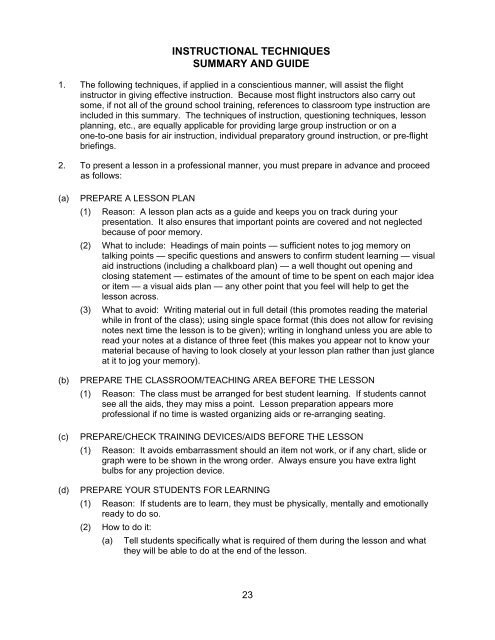FLIGHT INSTRUCTOR GUIDE Aeroplane - South African Civil ...
FLIGHT INSTRUCTOR GUIDE Aeroplane - South African Civil ...
FLIGHT INSTRUCTOR GUIDE Aeroplane - South African Civil ...
You also want an ePaper? Increase the reach of your titles
YUMPU automatically turns print PDFs into web optimized ePapers that Google loves.
INSTRUCTIONAL TECHNIQUES<br />
SUMMARY AND <strong>GUIDE</strong><br />
1. The following techniques, if applied in a conscientious manner, will assist the flight<br />
instructor in giving effective instruction. Because most flight instructors also carry out<br />
some, if not all of the ground school training, references to classroom type instruction are<br />
included in this summary. The techniques of instruction, questioning techniques, lesson<br />
planning, etc., are equally applicable for providing large group instruction or on a<br />
one-to-one basis for air instruction, individual preparatory ground instruction, or pre-flight<br />
briefings.<br />
2. To present a lesson in a professional manner, you must prepare in advance and proceed<br />
as follows:<br />
(a) PREPARE A LESSON PLAN<br />
(1) Reason: A lesson plan acts as a guide and keeps you on track during your<br />
presentation. It also ensures that important points are covered and not neglected<br />
because of poor memory.<br />
(2) What to include: Headings of main points — sufficient notes to jog memory on<br />
talking points — specific questions and answers to confirm student learning — visual<br />
aid instructions (including a chalkboard plan) — a well thought out opening and<br />
closing statement — estimates of the amount of time to be spent on each major idea<br />
or item — a visual aids plan — any other point that you feel will help to get the<br />
lesson across.<br />
(3) What to avoid: Writing material out in full detail (this promotes reading the material<br />
while in front of the class); using single space format (this does not allow for revising<br />
notes next time the lesson is to be given); writing in longhand unless you are able to<br />
read your notes at a distance of three feet (this makes you appear not to know your<br />
material because of having to look closely at your lesson plan rather than just glance<br />
at it to jog your memory).<br />
(b) PREPARE THE CLASSROOM/TEACHING AREA BEFORE THE LESSON<br />
(1) Reason: The class must be arranged for best student learning. If students cannot<br />
see all the aids, they may miss a point. Lesson preparation appears more<br />
professional if no time is wasted organizing aids or re-arranging seating.<br />
(c) PREPARE/CHECK TRAINING DEVICES/AIDS BEFORE THE LESSON<br />
(1) Reason: It avoids embarrassment should an item not work, or if any chart, slide or<br />
graph were to be shown in the wrong order. Always ensure you have extra light<br />
bulbs for any projection device.<br />
(d) PREPARE YOUR STUDENTS FOR LEARNING<br />
(1) Reason: If students are to learn, they must be physically, mentally and emotionally<br />
ready to do so.<br />
(2) How to do it:<br />
(a) Tell students specifically what is required of them during the lesson and what<br />
they will be able to do at the end of the lesson.<br />
23













